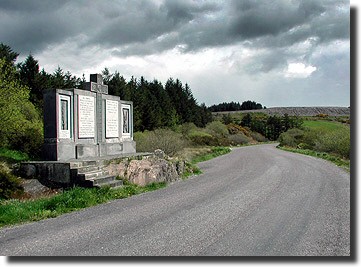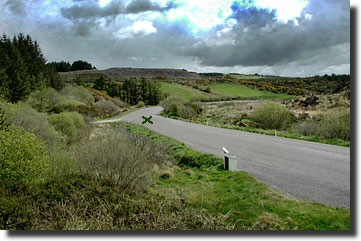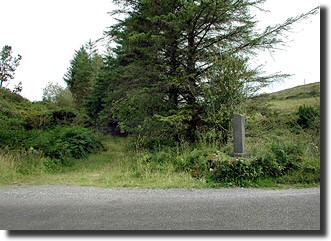|
Major Defeat For Auxiliaries at Kilmichael Ambush (Irish War of Independence - Third Cork Brigade) |
|
|
|||||||||||
|
One hundred and fifty members of the new force of
Auxiliaries arrived in Macroom in August 1920, and took over From the time of their arrival in Macroom they raided
constantly, travelling to places like Coppeen, Castletown-Kenneigh, Dunmanway
and even south of the Bandon river. Their modus operandi was simple. Fast
lorries would come roaring into a village, the occupants would jump out, firing
their guns, ordering all the inhabitants out of their houses. No exceptions
were allowed. Men and women, young and old, the sick and disabled, were lined
up against walls with their hands up, questioned and searched. For hours the
little community would be held prisoner with many suffering at the butt ends of
revolvers or rifles, The raiders commandeered food and drink and rarely
returned sober to their barracks. Observing some man working at his bog or
small field a few hundred yards from the road, four or five would take aim, not
to hit him, but to spatter the earth or bog round him. The man would run with
bullets clipping the sods around him. He would stumble and fall, rise again and
continue to run for safety. But sometimes he would not rise, as an Auxiliary
bullet was sent through him. The Auxiliaries had been allowed to roam through
the countryside for four or five months, terrorising and killing and not a
single shot had been fired at them up to that point. They were invincible in
the minds of many people. They had to be stopped. On November 21st. a column of thirty-six riflemen were
mobilised at Clogher, north-west of Dunmanway, for a week's training, in
advance of an attack on these Auxiliaries. At The Column started its march in lashing, rain and reached
the ambush position at 8.15 at dawn. The ambush area was in the centre of a
bleak and barren countryside, a bog land interspersed with heather and rocks.
It was bad terrain for an ambushing unit because of the lack of roadside
ditches and cover, but the Column had to attack in this area as there was no
certainty of meeting them anywhere except on this road between Kilmichael Cross
and Gleann Cross which they never once failed to travel.
A view of the ambush scene looking southwards. The first lorry was halted by a Mills bomb thrown by Comandant Tom Barry at the marked area. The point of this road chosen for the attack was one and a
half miles south of Kilmichael. Here the north-south road turns west-east for
150 yards and then resumes its north-south direction. There were no ditches on
either side of the road but a number of scattered rocky eminences of varying
sizes. No house was visible except one, 150 yards south of the road at the
western entrance to the position. Before being posted, the whole Column was paraded and
informed of the plan of attack. They were also told that the positions they
were about to occupy allowed for no retreat and
would be a fight to the end, All the positions were pointed out to the
whole Column, so that each man knew where his comrades were and what was
expected of each group. Details of the plan were as follows -
The command post used by the IRA at Kilmichael. Behind the low wall on the right were John 'Flyer' Nyhan, Jim 'Spud' Murphy and Mick O'Herlihy. The attack was launched from here. The first lorry
came round the bend into the ambush position at a fairly fast speed. Then
column commander Tom Barry, dressed in a military style uniform stepped onto
the road with his hand up. The driver of
the lorry, seeing the uniformed figure,
gradually slowed down. When it was thirty-five yards from the volunteers
command post a Mills bomb was thrown by Barry and simultaneously a whistle blew
signalling the beginning of the assault. The bomb sailed through the air to
land in the driver's seat of the uncovered lorry. As it exploded the rifle
shots rang out. The lorry, its driver dead, moved forward until it stopped a
few yards from the small stone wall in front of the command post. While some of
the Auxiliaries were firing from the lorry, others were on the road and the
fight became a hand-to-hand one. Revolvers were used at point blank range, and
at times, rifle butts replaced rifle shots. The Auxiliaries were cursing and
yelling as they fought, but the I.R.A. coldly outfought them. In less than five
minutes all nine Auxiliaries were dead or dying sprawled around the road,
except the driver and another who were lying lifeless in the front of the
lorry. The second lorry had stopped and was coming under fire from
No. 2 section. The Auxiliaries were
lying in small groups on the road returning fire. Three riflemen from the
command post, Murphy, Nyhan and O'Herlihy, moved in to attack the second party
from the rear when they heard the Auxiliaries shout "We surrender".
Some of them were seen to throw away their rifles. Firing stopped and three of
the volunteers in No. 2 Section stood up. The Auxiliaries began firing again
with revolvers and two of the three men fell. When he saw this Tom Barry gave the order, "Rapid fire
and do not stop until I tell you".
The Auxiliaries once again shouted "We surrender" but on
this occasion the order was given "Keep firing on them. Keep firing, No.
2 Section. Everybody keep firing on them until the Cease Fire". The small
I.R.A. group on the road was now standing up, firing as they advanced to within
ten yards of the Auxiliaries. When the cease fire order was finally given there
was an uncanny silence as the sound of the last shot died away. Sixteen
Auxiliaries were dead and one seriously wounded. Volunteers Michael McCarthy, Dunmanway and Jim Sullivan,
Rossmore also lay dead, and Pat Deasy was dying. The lorries were set ablaze. Like two huge torches, they lit
up the countryside and the corpse-strewn road. Some of the volunteers showed
the strain of the ordeal through which they had passed, and a few appeared on
the point of collapse because of shock. The entire column was ordered to drill
and march and for five minutes the eerie drill continued. They then halted in
front of the rock where Michael McCarthy and Jim O'Sullivan lay, where they
presented arms as a tribute to the dead volunteers. Just thirty minutes after
the opening of the ambush the column moved away to the south, intending to cross
the Bandon river upstream from the British held The following day the
volunteers remained at the cottage where they had billeted while reports of
intense enemy activity came in. Large forces of British were gathering at
Dunmanway, Ballineen, Bandon, Crookstown and Macroom before converging on Kilmichael.
One unit of 250 steel-helmeted soldiers moving on to Dunmanway about As already stated, the engagement at Kilmichael
was the first between the IRA and the previously
invincible Auxilaries and has long been recognised as being one of the most important battles of the
Anglo-Irish War.
LINKS ... The War of Independence 1919-2004: What Is The Dispute About Kilmichael And Dunmanway Really About? |
|
|


